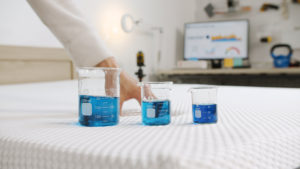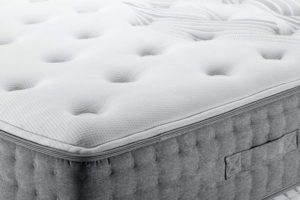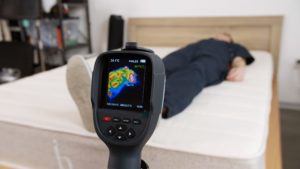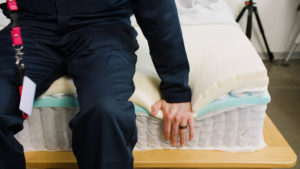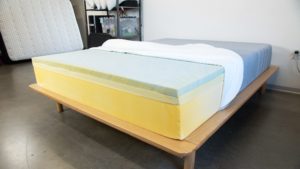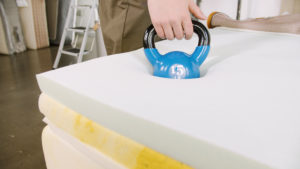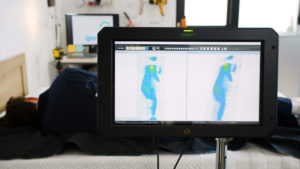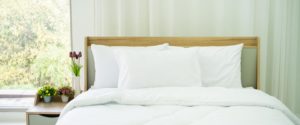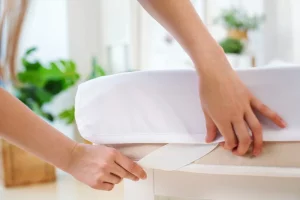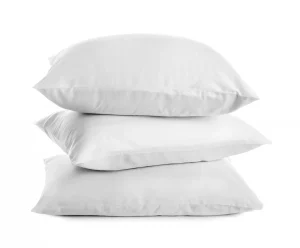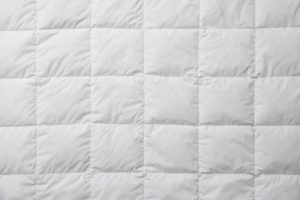Ease of Movement
If you find it challenging to move around on your sleep surface, you might be interested in stronger ease of movement. Certain mattress types, such as innerspring or latex models, tend to facilitate movement, making it easier to switch positions. By contrast, a mattress that inhibits movement can complicate the process of changing positions.
We know sleep is subjective. That’s why at the Test Lab manufacturer specifications as well as the quantitative measurements help us craft our ratings. As part of our stringent mattress testing, we carry out several experiments to analyze each model’s ease of movement. These tests include subjective evaluations by our in-house testing team as well as objective analyses using carefully refined procedures. Designed to imitate the experience of sleeping on a mattress, these assessments help us predict how easy it will be for different sleepers to move around on the surface.
We’ll discuss who may benefit most from ease of movement and how to find a mattress that aids movement. We’ll also examine how ease of movement interacts with other performance factors, such as motion isolation and pressure relief, to help you determine what’s most important to you.
What is Ease of Movement?
Ease of movement refers to how much effort is necessary to move around on a mattress. To perform well in ease of movement, a model should allow minimal sinkage and return quickly to its original shape when pressure is lifted.
A material that is slow to regain its original shape can leave body impressions that cause sleepers to feel trapped in the bed. Firmer mattresses tend to allow for better ease of movement compared to softer models that conform more closely.
The ability of a mattress to impair or promote movement depends partly on the sleeper’s body weight. Individuals who weigh over 230 pounds place more pressure on the mattress and sink in further as a result. For these sleepers, a mattress that is too soft is more likely to inhibit movement.
Who Should Care About Ease of Movement?
Getting in and out of bed should be easy, especially for people who toss and turn a lot. At the Test Lab, we analyze a mattress’s response to pressure changes and ability to regain its original shape. Combination sleepers typically prefer a mattress that facilitates movement. Ease of movement may also be important for people with limited mobility and couples looking for a surface conducive to sex.
However, sleepers who don’t mind staying in the same position for long stretches may not view ease of movement as a critical factor.
Some people may also prioritize other features over ease of movement. For example, mattresses that aid movement usually transfer more vibrations across the bed. This may be a drawback for individuals who sleep with a partner and awaken easily. Similarly, close-conforming mattresses often limit movement, but they also tend to provide the best pressure relief, which may be a greater priority for some sleepers with sharp aches and pains.
Mattress Materials and Ease of Movement
A mattress is made up of multiple layers, all of which impact the ease of movement. The most influential layers tend to be those closest to the sleeper’s body. These determine how far the sleeper sinks into the mattress, and they can provide more immediate pushback to prevent the feeling of being stuck. Mattresses with thicker comfort layers are more likely to restrict movement since the sleeper can sink in more deeply before reaching the support system, but this depends on the exact design and materials.
Most manufacturers strive to balance pressure relief and ease of movement by incorporating different materials, but a model may still excel in one area more than the other.
| Material | Description | Feel | Ease of Movement Performance |
|---|---|---|---|
| Memory Foam | Also known as viscoelastic foam, memory foam is a type of foam with additional compounds that give it special properties. Memory foam conforms closely to the sleeper and responds relatively slowly to changes in pressure. This material is often used in comfort systems. | Memory foam typically excels at contouring, hugging the body to reduce pressure at contact points. The material is popular with individuals with chronic pain and less popular with hot sleepers as it tends to trap heat around the body. Some models use infusions of phase change material, gel, copper, graphite, or other materials intended to counteract heat accumulation. | Since memory foam is slow to regain its original shape, it’s generally not considered the best material for ease of movement. Lower-density memory foam contours less closely, which may be slightly better for ease of movement. |
| Polyfoam | Polyfoam, or polyurethane foam, is a synthetic material produced using petrochemicals. It can have different properties depending on the density and cell structure. This versatility makes it suitable for either the comfort layers or the support core. | Polyfoam conforms to a certain extent, but it usually has less sinkage and a quicker response to pressure changes than traditional memory foam. It’s common to find polyfoam layers that have cut-out grooves for zoned pressure relief and support. | Many polyfoam mattresses are designed to conform closely, though this material generally offers greater ease of movement than memory foam. Some proprietary polyfoam has a springiness that mimics latex. Other varieties are quite firm, facilitating movement by keeping sleepers on top of the mattress. |
| Latex | Natural latex is made with the sap of the rubber tree, while synthetic latex consists of chemicals called styrene and butadiene. Latex production uses one of two methods: Talalay or Dunlop. The Talalay process produces a lighter, more buoyant latex, while the Dunlop process creates a denser material. | Latex is naturally springy. It forms a loose cradle around the sleeper’s body, though it doesn’t contour to the same extent as memory foam. This material tends to keep sleepers mostly on, as opposed to in, the mattress. | The natural bounce of latex is very conducive to movement, and most sleepers have little trouble switching positions on a latex mattress. Talalay latex may allow more sinkage, but it also tends to be springier. Dunlop latex is usually firmer, minimizing sinkage. |
| Microcoils | Microcoil layers consist of multiple small steel springs. Each coil is typically encased in fabric and designed to flex independently in response to pressure. Because of their smaller size and ability to conform locally, microcoils are often used for comfort and transitional layers. | Used beneath a cushioning layer, microcoils help cradle the body more deeply. This provides a balance of pressure relief and support. | Because coils are inherently springy, including a microcoil layer closer to the top of the mattress tends to improve ease of movement. This effect can be enhanced if the microcoil layer is paired with a coil or latex base. |
Ease of Movement by Mattress Type
Although it’s farther from the sleeper’s body, the support core can also contribute to ease of movement. Knowing the mattress type and understanding how the support core and comfort system work together can give you a general idea of a mattress’ responsiveness.
Innerspring: As innerspring mattresses consist almost entirely of coils, they tend to offer greater ease of movement than other mattress types. Steel coils support sleepers without allowing them to sink into the mattress, and they bounce back almost immediately when pressure is lifted.
Hybrid: The coils in hybrid mattresses add bounce, so hybrid models are usually easier to move on than similarly built foam mattresses. However, hybrids with thick, plush comfort layers may absorb more vibrations and muffle pushback from the coils, thereby diminishing the springiness.
Latex: Mattresses with latex support cores are typically quite responsive, especially if they also have latex or microcoil comfort layers. Most latex mattresses use Dunlop latex for the support core because of its sturdiness and durability. These traits should also foster mobility.
Foam: All-foam models with polyfoam support cores tend to absorb vibrations. Although polyfoam in and of itself doesn’t typically inhibit movement significantly, polyfoam support cores aren’t inherently bouncy, so the ease of movement is more dependent on the comfort layers.
Airbed: On their own, air chamber support cores aren’t as responsive as most coil or latex options. That said, pumping in more air to make a firmer surface can improve ease of movement by reducing sinkage. Ultimately, an airbed’s ease of movement also depends largely on the comfort system since it influences the amount of contouring.

How Do We Test for Ease of Movement?
Despite similarities in construction and materials, each mattress performs slightly differently in ease of movement. To form an idea of how a mattress compares to others in its category, our in-house testing team analyzes each model using a series of objective and subjective tests. These evaluations are designed to mimic the experience of lying on the bed, incorporating the perceptions of human testers as well as quantifiable measurements.
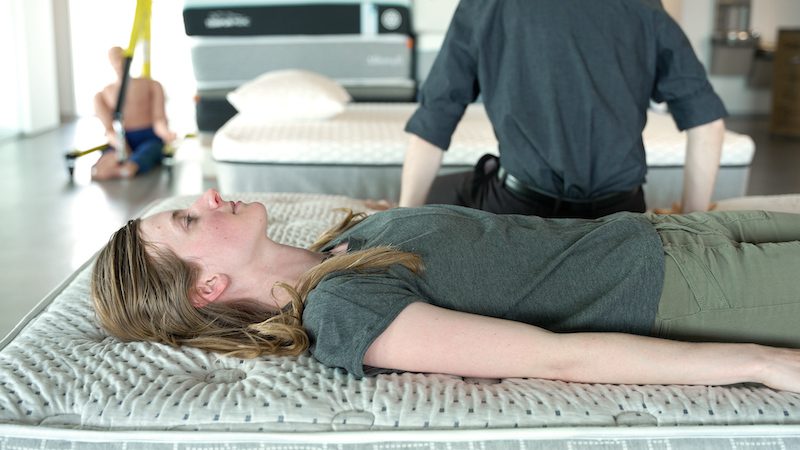
Body Testing
During body testing, our testers evaluate the subjective experience of interacting with the mattress.
One by one, each member of the testing team lies on one side of the bed and goes through a series of typical movements. These include sitting on the edge of the bed, getting in and out of bed, tossing and turning, and switching between back, side, and stomach sleeping. Next, they perform movements designed to test the limits of the mattress, such as pressing as deeply as they can into the mattress and crawling across the bed on all fours.
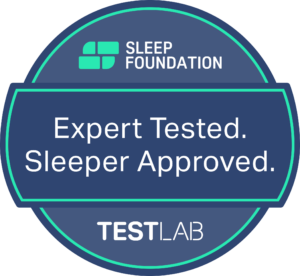

Testers carry out these movements both slowly and quickly and note how the mattress performs on each metric. Each tester carries out the same assessments on multiple mattresses so that they can judge how each mattress stacks up compared to similarly built models. During all tests, we place the mattress on a reinforced foundation to minimize the potential for interference from a wobbly bed frame.
To gain a realistic view of how a mattress performs for different sleeper types, the testing team includes individuals with varying body types and preferred sleeping positions. These sleeper types parallel the types we reference in our mattress reviews: back, side, stomach, and combination sleepers who weigh less than 130 pounds, between 130 and 230 pounds, and more than 230 pounds.
Responsiveness Test – Kettlebell
For a more objective analysis of a mattress’ response to changes in pressure, we test different areas of the surface using a 15-pound kettlebell, which is roughly equivalent to the weight that a sleeper would place on a given part of the mattress.
As some materials take longer to conform in response to pressure, the kettlebell is allowed to rest for 5 minutes at a time on different areas of the mattress. We then take it off and measure how quickly the comfort layers regain their original shape. A mattress that bounces back faster generally allows for easier movement.
To minimize confounding variables during this experiment, we always let the kettlebell sit for exactly 5 minutes, and we follow a consistent timing system after removing the kettlebell. Our testing team consists of multiple people who come to a consensus about when the mattress has returned to its original shape.
We’re also interested in whether certain areas of the mattress perform better than others, so we assess a set of predetermined spots that remain consistent from mattress to mattress. This method is designed to give a holistic view of the entire mattress surface, which may be especially relevant for zoned models or those with reinforced edge support.
Learn more about the Test Lab at the link below.

Frequently Asked Questions About Ease of Movement
To an extent, you can change how easy it is to move around on your bed by adding or removing layers on top or adjusting the type of foundation. A thick memory foam mattress topper usually hampers movement. By contrast, adding a latex model or a firmer polyfoam option can help enhance mobility, but this method may be less effective for mattresses with thick, plush comfort systems.
Ensuring the mattress rests on a supportive, compatible foundation can also help improve the ease of movement by limiting sinkage.
The best mattress options for ease of movement include those with latex and/or coil layers, both of which provide strong pushback. Many hybrid models also excel in this category, barring those that have very plush or thick comfort layers. Although all-foam mattresses generally earn the lowest marks in ease of movement, firmer models are adequate for most people as they don’t allow sleepers to sink in as far.
Strong ease of movement often goes hand-in-hand with a lower degree of motion isolation and pressure relief. This is because materials that conform more closely tend to absorb vibrations and cushion pressure points. Sleepers who are interested in all three factors may want to consider mattresses with wool, latex, or polyfoam comfort layers, which typically offer decent ease of movement without compromising too much on motion isolation and pressure relief.
As they age, memory foam and polyfoam become softer and slower to respond to pressure changes, which may negatively impact ease of movement. Latex and innerspring mattresses tend to be more consistent.


